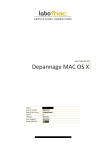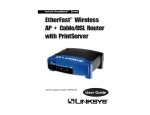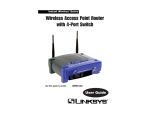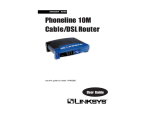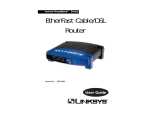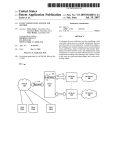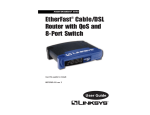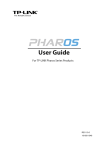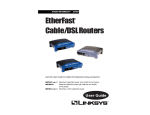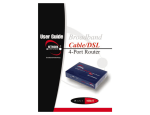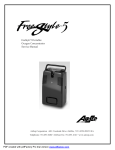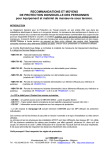Download Event notification system and method
Transcript
US 20120036517Al (19) United States (12) Patent Application Publication (10) Pub. No.: US 2012/0036517 A1 TAYLOR et al. (54) 43 Pub. Date: EVENT NOTIFICATION SYSTEM AND METHOD (75) Inventors: Feb. 9 9 2012 Publication Classi?cation (51) Int. Cl. Paulo TAYLOR, Amsterdam (NL); G06F 9/46 (200601) Jan-J oost Rueb, Amsterdam (NL); Onno Bakker, Amsterdam (NL) (73) Assignee: (52) US. Cl. ...................................................... .. 719/318 eBuddy Holdings B.V., Amsterdam (57) ABSTRACT (21) Appl, No.1 13/165,709 A technique for user noti?cation involves modifying a title (22) Jun. 21, 2011 event that calls for user noti?cation. A method according to the technique may include running a process, processing an event, generating a string of characters that includes informa associated With a process to include information about an Filed: Related US- Application Data . . . (62) ’ (60) . . tion associated With the event, and displaying the string of of appglctailon ’ now a ' 0' ’ 12/?7’514’ ?led on Dec' characters as a title associated With the process. A system ’ constructed according to the technique may include a client, ' Provisional application No, 60/748,988, ?led on Dec, a title array, an event processing engine, and a title provision 9,2005. ing engine. 600 N Input Device 522. Output Device 595 Event Event D‘ Compmer _____________________'s"'_af Title Strlng(s) s10 lnterface @12. I I . l Event Processing Engine I m | 7 I Title Provisioning Engine 5.16 Control Client Control 7 Title Array MUX m 53g f‘ 622 W Title Generator Q25 Title Array String in l : i l Title Array String [0] Title Array String [N] | ‘ 5 Title String 5% , U| i i l Patent Application Publication Feb. 9, 2012 Sheet 1 0f 11 US 2012/0036517 A1 S:hma mw 5. A?rllgv 52z“was .OKP w P w NF a.“.I hm.amw0 w OP E2E520 7wv8é:%: Q24/ Patent Application Publication Feb. 9, 2012 Sheet 2 0f 11 US 2012/0036517 A1 E20 31w. uwBm?QsoSHO 2:25626. 7Mz9um?s"w 2?5oié2gw%zm mam7Ilgm 52.9 2om: E25 MUM .91w Patent Application Publication Feb. 9, 2012 Sheet 3 0f 11 US 2012/0036517 A1 .OE(m Patent Application Publication Feb. 9, 2012 Sheet 4 0f 11 US 2012/0036517 A1 F3BIG. Patent Application Publication Feb. 9, 2012 Sheet 5 0f 11 US 2012/0036517 A1 .OEOm .i. hiM. mA215! .3Q;2.5 BU3hgvi5.wlnit. mu283 5 étogbinlw I -‘g aav‘Quit min ‘10 .? Patent Application Publication Feb. 9, 2012 Sheet 6 0f 11 E34 XI-1.0259 ‘iIt: GiRnI!D mAa3vg-5I.! . Q2sa5gi .‘ fi1g" t; 18a b.‘ ‘I? £53 than‘? US 2012/0036517 A1 .OEOm ilV‘vatd-36 Patent Application Publication Feb. 9, 2012 Sheet 7 0f 11 US 2012/0036517 A1 Start y F 402 Run IM client process 404 Event received? r Terminate IM client? f4 10 Process event f“ 408 . Termmate IM client process 412 . Notify user’? N Ye s 7 End r 414 Modlfy tltle asscclated with IM client process FIG. 4 Patent Application Publication Feb. 9, 2012 Sheet 8 0f 11 l Start US 2012/0036517 A1 l f- 502 Open browser r f- 504 Display in association with a browser a title associated with state of the browser + , r 5 06 Receive an event trigger l / 508 Display in association wlth a browser a title associated with the event 510 Close browser? Yes N 512 Continue to display? Yes [- 514 Close browser End FIG. 5 Patent Application Publication Feb. 9, 2012 Sheet 9 0f 11 Input Device Output Device Q95 522. interface £12 I Event Processing Engine Q15 Title String(s) Title Provisioning Engine 51E Control Control 7 Title Array 515 Title Array String [0] Title Array String [1] Title Generator £525 Title Array String [N] FIG. 6 US 2012/0036517 A1 Patent Application Publication Feb. 9, 2012 Sheet 10 0f 11 ( Start US 2012/0036517 A1 i r /' 702 Process event that caiis for user noti?cation r f 704 Generata a ?rst string of characters associated with the event r F 7706 Store the ?rst string of characters in an array r / 708 Providing the ?rst string of characters from the array to a process r f 710 Using the ?rst string of characters as a this in association with the process I r- 712 Providing a second string of characters from the array to the process I f- 714 Using the second string of characters as a title in association with the process End FIG. 7 Patent Application Publication Feb. 9, 2012 Sheet 11 0f 11 US 2012/0036517 A1 800 a Cemputer §QZ P rocessor Q95 Comm Interface ?lQ Memory £32 / 820 Display Control 5.1.4 NV Storage m l/O Control 515 1/0 Devices @051 FIG. 8 Disptay Device 595 Feb. 9, 2012 US 2012/0036517 A1 EVENT NOTIFICATION SYSTEM AND METHOD process, a browser, or some other process that has a title CROSS-REFERENCE TO RELATED APPLICATIONS tion, a new mail event, a new instant message event, a [0001] This Patent Application is a divisional application of US. Ser. No. 11/637,514, ?led Dec. 11, 2006, entitled EVENT NOTIFICATION SYSTEMAND METHOD, which claims priority to US. Provisional Patent Application Ser. No. 60/748,988, ?led Dec. 9, 2005, which are incorporated herein by reference. This Patent Application is related to US. associated therewith. The method may further include pro cessing an event, such as by way of example but not limita reminder event, a calendar event, or some other event, and generating a string of characters that includes information associated with the event. The method may further include displaying the string of characters as a title associated with the process. A system constructed according to the technique may include a client, a title array, an event processing engine, and a title provisioning engine. patent application Ser. Nos. 12/721,538, ?led Mar. 10, 2010, BRIEF DESCRIPTION OF THE DRAWINGS entitled HIGH LEVEL NETWORK LAYER SYSTEM AND METHOD, which is a continuation of US. Pat. No. 7,730, [0007] 144, ?led Dec. 11, 2006; 11/637,268, ?led Dec. 11, 2006, ?gures. However, the embodiments and ?gures are illustra entitled PICTURE PROVISIONING SYSTEM AND METHOD; 11/637,964 ?led Dec. 11, 2006, entitled MES Embodiments of the inventions are illustrated in the tive rather than limiting; they provide examples of the inven SAGE HISTORY DISPLAY SYSTEMAND METHOD; and tion. [0008] 11/637,316 ?led Dec. 11, 2006, entitled CONTACT LIST instant messages to clients via a web interface. DISPLAY SYSTEM AND METHOD. [0009] FIG. 1 depicts an example of a system for providing FIG. 2 depicts an example of a system for displaying content from an IM client at an alternative IM client. BACKGROUND [0002] Instant messaging requires the use of a client pro gram that hooks up an instant messaging service and differs from e-mail in that conversations are then able to happen in real time. Most services offer a presence information feature, indicating whether people on one’s list of contacts are cur rently online and available to chat. This may be called a contact list. In early instant messaging programs, each letter appeared as it was typed, and when letters were deleted to correct typos this was also seen in real time. This made it more like a telephone conversation than exchanging letters. In modern instant messaging programs, the other party in the conversation generally only sees each line of text right after a new line is started. Most instant messaging applications also include the ability to set a status message, roughly analogous to the message on a telephone answering machine. [0003] Popular instant messaging services on the public Internet include .NET Messenger Service, MSN Messenger, AOL Instant Messenger, Excite/Pal, Gadu-Gadu, Google Talk, iChat, ICQ, Jabber, Qnext, QQ, Meetro, Skype, Trillian and Yahoo! Messenger. These services owe many ideas to an older (and still popular) online chat medium known as Inter net Relay Chat (IRC). [0004] The foregoing examples of the related art and limi tations related therewith are intended to be illustrative and not exclusive. Other limitations of the related art will become apparent to those of skill in the art upon a reading of the speci?cation and a study of the drawings. SUMMARY [0005] The following embodiments and aspects thereof are described and illustrated in conjunction with systems, tools, [0010] FIGS. 3A-3D depict examples of screenshots with IM noti?cation functionality. [0011] FIG. 4 depicts a ?owchart of an example of a method for changing a title associated with a titlebar. [0012] FIG. 5 depicts a ?owchart of an example of a method for displaying an event-related title. [0013] FIG. 6 depicts an example of a system for pro grammed text event-speci?c title provisioning. [0014] FIG. 7 depicts a ?owchart of an example of a method for displaying programmed text titles. [0015] FIG. 8 depicts a computer system suitable for imple mentation of the techniques described above with reference to FIGS. 1-7. DETAILED DESCRIPTION [0016] In the following description, several speci?c details are presented to provide a thorough understanding of embodi ments of the invention. One skilled in the relevant art will recogniZe, however, that the invention can be practiced with out one or more of the speci?c details, or in combination with other components, etc. In other instances, well-known imple mentations or operations are not shown or described in detail to avoid obscuring aspects of various embodiments, of the invention. [0017] FIG. 1 depicts an example of a system 100 for pro viding instant messages to clients via a web interface. In the example of FIG. 1, the system 100 includes a network 102, a server 104, and an Instant Messenger (IM) server 106, and an IM network 108. The server 104 is coupled to the network at least by way of port 80. The two way communication via port 80 is represented in the example of FIG. 1 as an arrow 110. The server 104 is coupled to the IM server 106 via one or more and methods that are meant to be exemplary and illustrative, other ports. The two way communication via the other ports is not limiting in scope. In various embodiments, one or more of represented in the example of FIG. 1 as an arrow 112. The IM server 106 is coupled to the IM network 108 via any known or convenient mechanism. Indeed, the IM server 106 may be thought of as part of the IM network 108. The network 102 the above-described problems have been reduced or elimi nated, while other embodiments are directed to other improvements. [0006] A technique for user noti?cation involves modify couples a plurality of clients 114-1 to 114-N (referred to collectively as clients 114) to the server 104. In the example ing a title associated with a process to include information about an event that calls for user noti?cation. A method of FIG. 1, the server 104 includes an event queue 116. according to the technique may include running a process, such as, by way of example but not limitation, an IM client [0018] The network 102 may include by way of example but not limitation LAN, WAN, VLAN, WLAN, Internet, cel Feb. 9, 2012 US 2012/0036517 A1 lular network, phone network, radio network, or some other [0025] known or convenient network. The term “Internet” as used herein refers to a network of networks that uses certain pro send data to the server 104. The data, which may include To interact with the IM network 108, the clients 114 commands, is processed and translated into corresponding tocols, such as TCP/IP, and possibly other protocols such as data that will be sent to the appropriate IM network. In an the hypertext transfer protocol (HTTP) for hypertext markup embodiment, the appropriate IM network may be determin language (HTML) documents that make up the World Wide Web (the web). The physical connections of the Internet and the protocols and communication procedures are well known, able based upon the protocol encoded in a message. [0026] Messages or actions from the clients 114 are col but any convenient physical connections or protocols could be used. not limitation, HTTP or plain socket connections. The mes sages or actions are transformed to an appropriate protocol format to be sent over a compliant port from the clients 114 to the server 104, with the IM protocol on the application side. In [0019] The server 104 may include a multiple servers. Indeed, it may be desirable, depending upon details of a particular implementation, to install several servers to cope lected over network protocols such as, by way of example but a non-limiting embodiment, the compliant port is http port 80. with the number of simultaneous users the system 100 sup ports. It may further be desirable, depending upon details of a particular implementation, for the server 104 to have a high typical port 80 could be used. [0027] The latest available browsers, as of December 2005, CPU throughput, together with large amounts of RAM, to enable the use of a technique called AJAX (Asynchronous However, any port having similar characteristics to those of a handle a large number of users. It may further be desirable, JavaScript And XML). With AJAX, appropriately con?gured depending upon details of a particular implementation, to accomplish resource sharing via thread handling where a pool clients 114 can execute actions and poll for messages or of threads is shared and used by one or more of the clients 114 for client-server communication and between the server 104 and the IM server 106. [0020] The server 104 may include one or more of an appli cation server, database server, web server, banners server, and content server, or any combination thereof. To make the most of the techniques described herein, the server 104 should, though is not required to, include at least one application server. The other servers can have supporting roles in, by way of example but not limitation, serving static content or adver tising (e.g., banners), storing usage data, or ful?lling some other known or convenient function. [0021] The server 104 may act as a proxy server between the clients 114 and the IM server 106. The server 104 receives communications from the clients 114 on http port 80, and responds to the clients 114 on http port 80. Communications from the clients 114 that are bound for the IM network 108, however, must also come through http port 80 to the server 104, and are then forwarded to the IM server 106. In this way, events using only JavaScript. The method is based on using an XMLHttpRequest object to make HTTP requests to the server 104. The server 104 may reply with messages taken from the queue of the corresponding session in XML (or another) format that are parsed and displayed according to the mes sage content. [0028] For clients 114 that include a browser, when access ing the server 104 the browser typically uses hidden HTML frames to update information on visible frames. The visible frames display appropriate information while the hidden frames are reloaded in short periods of time. In each refresh that hits the server 104, the browser identi?es the current messaging session and checks if new events or messages associated with the session are in the event queue 116. When new information arrives and needs to be displayed in some form, the browser makes use of, for example, JavaScript code to update the visible frames and windows with new messages or events keeping the information up to date in the screen. In this way, automatic refreshing can take place in a hidden frame. the server 104 acts as a carrier of the data from users to the IM [0029] network 108 using a mechanism that controls and manages with browsers may not make use of refreshes. For example, a the data (e.g., text messages, display images, emoticons, form of updating the screen without using a refresh technique is to keep one single HTTP socket request alive for the whole audio/video streams, etc.) sent between one of the clients 114 In another embodiment, certain of the clients 114 and the server 104, and vice versa. [0022] The IM server 106 may be any known or convenient IM server that is compatible with IM. Events, messages, or other appropriate data from the IM server 106 are collected in the event queue 116 of the server 104. The events may be period of a messaging session without actually closing the socket connection. In this example, information is initially collected in association with a variety of protocols including by way of example but not limitation port 1863, port 5050, port 5222, port 5190, etc. through the same HTTP socket kept alive and managed by the [0023] The IM network 108 may include one or a combi nation of networks selected from MSN Messenger, Yahoo! loaded and displayed in one single visible frame. While events and messages are being received by the server 104, JavaScript code can be injected into the HTML document server 104. For each event or message, the browser can inter pret the JavaScript code injected and the corresponding parts of the HTML document and windows will be updated. [0030] In another embodiment, certain of the clients 114 Messenger, AIM AOL, ICQ, QQ, Jabber, Google Talk, IRC, with browsers may make use of manual refreshes. Some or some other known or convenient IM network. relatively unsophisticated browsers, such as WAP and [0024] xHTML browsers often available on mobile phones, do not The clients 114 may include any known or conve nient device, including by way of example but not limitation, a Web browser, mobile client, PDA, game console, TV box, native application, etc. The clients poll the server 104 for support hidden frames and/or JavaScript (and others may be con?gured such that they do not support hidden frames and/or JavaScript). In such cases, the information displayed has to be events. The events can be removed from the event queue 116 updated manually by the user. Manual updating enables any and translated into text, JavaScript, XML, or some other mobile phone, PDA, TV Set or any device with a browser to connect to the server 104 and use the messaging platforms known or convenient format that one or more of the clients 1 14 need or expect in order to process data associated with the made available by the server 104 assuring the communication event. between the clients 114 and the IM server 106. Feb. 9, 2012 US 2012/0036517 A1 [0031] Message history can be stored by most IM clients on a local computer. For alternative Web and mobile-based.cli ents local storage may not be possible. In a non-limiting embodiment, the server 104, may have the capability to store neW message is available. The IM noti?cation functionality may be cool on a desktop, but can be particularly useful in other implementations. searched at any time via the server 104 by one or more of the [0038] For example, notifying a user When neW messages arrive or events happen can gracefully be done by a native IM application. HoWever, for alternative Web clients this is more di?icult given the nature of control from Within a broWser to clients 114 the Operating System. There is less control for alerts like message history from IM conversations done via one or more of the clients 114. The message history can be accessed and [0032] FIG. 2 depicts an example ofa system 200 for dis playing content from an IM client at an alternative IM client. In the example of FIG. 2, the system 200 includes a client 202, an IM netWork 204, a server 206, an IM netWork 208, a client 210, other IM netWorks 212-1 to 212-N (referred to collec tively as other IM netWorks 212), and other clients 214-1 to 214-N (referred to collectively as other clients 214). [0033] For illustrative purposes, it is assumed that the client 202 has content that is compatible With the IM netWork 204. HoWever, the client 210 is capable of reading content format ted to be compatible With the IM netWork 208. Thus, in operation, the server 206 collects content from the client 202 (either through the IM netWork 204, as shoWn in FIG. 2, or directly from the client 202, such as is shoWn by Way of example in FIG. 1). The server 206 then formats the content as appropriate for use on the IM netWork 208. Once the content is properly formatted, it can be made available to the client 210 (either through the IM netWork 208, as shoWn in FIG. 2, or directly to the client 210, such as is shoWn by Way of example in FIG. 1). Depending upon the embodiment and/or implementation, the content may also be formatted as appro priate for one or more of the other IM netWorks 212, to be made available for one or more of the other clients 214. [0034] As is Well-understood, different devices provide dif ferent functionality. For example, a desktop typically pro vides greater storage, greater display area, and greater poWer than a cell phone. Thus, at best, an IM client must Work under the constraints imposed by a particular device. Depending ?ashing WindoWs etc. from broWsers. In such cases, it may be particularly advantageous for a server to be able to provide a user With alerts for neW messages or events using the title bar, task bar, or other display area of a broWser. [0039] In the example of FIG. 3C, the Firefox® broWser is open, and the taskbar item 306 indicates the current site is WWW.ebuddy.com. The titlebar 308 includes similar informa tion. If a neW message is received, then both the titlebar and the taskbar can be changed. [0040] In the example of FIG. 3D, the taskbar includes the Firefox® Web broWser With a changed taskbar item 310. The titlebar 312 is also changed to indicate a neW message has been received. The exact information in a titlebar, taskbar, or other display area is implementation speci?c. Thus, the title bar 312 is simply illustrative. When an event, message, or other data is available to the client, the titlebar 312 may change to shoW information about the event. If properly con ?gured, the taskbar item 310 and the titlebar 312 could even display different information (though in a typical implemen tation the text is identical, albeit often necessarily shortened on the taskbar). [0041] The title can be used to notify users of certain events by changing the title of the IM client. The changing of the text in the taskbar and/or titlebar may stand out from other task bars and/or With ?xed texts. [0042] FIG. 4 depicts a ?owchart 400 of an example ofa method for changing a title associated With a titlebar (and an associated taskbar item, if applicable). In the example of FIG. 4, the ?owchart 400 starts at module 402 Where an IM client process is running. The IM client process may include, by upon the device, certain functionality may be more useful. For example, a device may have inferior capabilities With Way of example but not limitation, a broWser. respect to notifying a user When a message is received. ues to decision point 404 Where it is determined Whether an event has been received. If it is determined that an event has [0035] The device capabilities may limit the Way in Which a user can be noti?ed When a message is received. The envi ronment in Which a user operates may provide another limi tation. For example, a user at Work may not Want to play a noise or have a popup WindoW shoW up every time a message is received. Similarly, a user Who gets lots of messages may not Want to hear the noise or see the popup WindoWs because of the great frequency With Which it occurs. Advantageously, noti?cation can take place in a titlebar, Which is great for devices that have inferior noti?cation functionality, and great [0043] In the example of FIG. 4, the ?oWchart 400 contin not been received (404-N), then the ?oWchart 400 continues to decision point 406 Where it is determined Whether to ter minate the IM client process. If it is determined that the IM client process is to be terminated (406-Y), then the ?oWchart 400 continues to module 408 Where the IM client process is terminated, and the ?oWchart 400 ends. If, on the other hand, it is determined that the IM client process is not to be termi nated (406-N) then the ?oWchart 400 loops back to decision point 404, as described above. for users Who Want a subtle noti?cation. [0044] [0036] a taskbar, or some other menu or display item. In the example IM client process is not terminated (408), it is determined that an event has been received (404-Y), and the ?oWchart 400 continues to module 410 Where the event is processed. Events of FIG. 3A, the taskbar includes a process identi?ed by the are processed in a knoWn or convenient manner. FIGS. 3A-3D depict examples of screenshots 300 With IM noti?cation functionality. The bar may be a titlebar, In the example of FIG. 4, eventually, assuming the taskbar item 302. For illustrative purposes, the process is a [0045] Firefox® Web broWser that is at the site WWW.ebuddy.com. ues to decision point 412 Where it is determined Whether noti?cation is called for. Events may or may not result in noti?cation of a user, depending upon the event, embodiment, The screenshot appears as a conventional screen might look. HoWever, When a neW message arrives, the taskbar changes. In the example of FIG. 4, the ?oWchart 400 contin In the example of FIG. 3B, the taskbar includes the implementation, device limitations, and/or user’s IM client Firefox® Web broWser process, but the taskbar item 304 con?guration. If it is determined that user noti?cation is called for (412-Y), then the ?oWchart 400 continues to mod ule 414 Where a title associated With the IM client process is [0037] appears differently. Speci?cally, rather than depicting the site WWW.ebuddy.com, the taskbar item 304 noW indicates that a Feb. 9, 2012 US 2012/0036517 A1 modi?ed. If, on the other hand, it is determined that user noti?cation is not called for (412-N), or in any case after another application. The changing taskbar would bene?t cli module 414, the ?owchart 400 loops back to decision point applications to run at the same time, e. g. Mail client, Browser, IM, etc. While users are switching between various applica 406, as described above. [0046] Modifying the title (414) presumably modi?es the display in the applicable titlebar and/or the display in the applicable taskbar item. Conventional browsers typically do ents on devices using a desktop system that allows multiple tions and an IM client they may not be aware of new mes sages/events that have arrived. The alternating messages can not allow setting a title in a titlebar that is different from the be seen in a taskbar even if, for example, the browser window is minimized or behind other application or browser windows corresponding taskbar item. However, a display area could (as in FIGS. 3A, 3B). display information different from that of the title, if con?g ured appropriately. Moreover, future browsers may include functionality that allows displaying different titles in the title bar and the taskbar. [0047] The title of the application may or may not keep the changed value until the user takes some action (e.g., clicking on the taskbar item associated with the IM client process). For example, the original title could be displayed after a certain amount of time has passed (e.g., a “new message” title could last for 10 seconds before reverting to the original title). FIG. 5 depicts a ?owchart 500 of an example of a method for displaying an event-related title. In the example of FIG. 5, the ?owchart 500 starts at module 502 where a browser is opened. [0048] In the example of FIG. 5, the ?owchart 500 contin ues to module 504 a title associated with state of a browser is displayed in association with the browser. The state of the browser may include, for example, a current site for which the browser is displaying a page, as is shown in FIGS. 3A and 3C. In general, the title associated with state of the browser includes any title that would normally be displayed in asso ciation therewith prior to updating the title in response to an event noti?cation. [0049] In the example of FIG. 5, the ?owchart 500 contin [0054] Advantageously, in an embodiment, a title associ ated with an event can include programmed text effects. FIG. 6 depicts an example of a system 600 for programmed text event-speci?c title provisioning. The system 600 includes an input device 602, a network 604, an output device 606, and a computer 610. The input device 602 may be any known or convenient device that is capable of generating or forwarding events to the computer 610. In a typical implementation, events will be received at the computer 610 via the network 604. Most computers include output devices for on which a variety of output is displayed. [0055] The computer 610 includes an interface 612, an event processing engine 614, a title provisioning engine 616, a title array 618, a multiplexer 620, and a client 622. The interface 612 may include an implementation-speci?c num ber of different kinds of known or convenient interfaces. The input device 602, the network 604, and the output device 606 are coupled to the computer 610 using the interface 612. [0056] An event received on the interface 612 (from either the input device 602 or the network 604) is provided to the event processing engine 614 for processing in a known or convenient manner. The event processing engine 614 may be event trigger is associated with an event that calls for notify embodied in a computer-readable medium. If user noti?ca tion is desired for the event, the user can be noti?ed in any ing a user. known or convenient manner. ues to module 506 where an event trigger is received. The [0050] For example, the event trigger may include receipt of a new instant message. [0051] In the example of FIG. 5, the ?owchart 500 contin ues to module 508 where a title associated with the event is displayed in association with the browser. Thus, the title associated with the state of the browser is replaced by the title associated with the event. Moreover, in a non-limiting embodiment, the state of the browser is unchanged (other than the title, of course). [0052] In the example of FIG. 5, the ?owchart 500 contin [0057] Advantageously, data associated with the event can also (or in the alternative) be provided to the title provisioning engine 616. The title provisioning engine 616 may be embod ied in a computer-readable medium. In the example of FIG. 6, the title provisioning engine 61 6 inputs title strings, which are strings of characters, to the title array 618. The title array 618 includes N-l title array strings, embodied in a computer readable medium, which are referenced (for illustrative pur poses) as title array string [0] to title array string [N]. [0058] A given event may cause the title provisioning engine 616 to rewrite the entire title array 618 with title strings associated with the most recent events. Alternatively, a given event may cause the title provisioning engine 616 to append title strings to the end of the title array 618. In a ues to decision point 510 where it is determined whether to close the browser. If the browser is not to be closed (510-N), then the ?owchart 500 continues to decision point 512 where it is determined whether to continue to display the title asso ciated with the event. If so (512-Y), then the ?owchart 500 non-limiting embodiment, the title provisioning engine 616 loops back to module 508, as described previously. If not (512-N), then the ?owchart 500 loops back to module 504, as updates the current title array 618 by adding new data asso ciated with an event, excluding redundant data (e. g., data that described previously. The determination as to whether to continue to display the title associated with the event may be based upon, by way of example but not limitation, a noti?ca is already represented in the title array 618). [0059] In the example of FIG. 6, the multiplexer 620 selects tion timer, an event- speci?c timer, a user action, or some other one of the title array strings for provisioning to the client 622. The multiplexer 620 receives a control signal from the title action that is su?icient to indicate that the title associated with provisioning engine 616 to accomplish this task. The multi the event should not longerbe displayed. If, on the other hand, the browser is to be closed (510-Y), then the ?owchart 500 continues to module 514 where the browser is closed, and the ?owchart 500 ends. [0053] The title of, e.g., a window shows up in both the plexer 620 is a conceptual construct that is intended to illus trate selecting one of the title array strings using an index to the title array 618. Thus, the multiplexer 620 may or may not be embodied in a computer-readable medium. It should be noted that the multiplexer 620, in at least one embodiment, is titlebar of a window and in the taskbar. Advantageously, users can be noti?ed of events in the taskbar, while they are using not a hardware MUX, though it could conceivably be imple mented as such. Feb. 9, 2012 US 2012/0036517 A1 [0060] In the example of FIG. 6, the client 622 includes a title string 624 and a title generator 626. The client 622 may include, by way of example but not limitation, an IM client, an email client, a VoIP client, or some other communications related client. The client 622 may include a window, panel, or some other display that includes a title. The title generator 626 generates a title for the display in a known or convenient manner. [0061] However, in a non-limiting embodiment, the title provisioning engine 616 controls the title generator 626 to either generate a title in the usual way (e.g., using the state of the client 622 to determine an appropriate title), or to not generate a title because a title string is available from the title array 618. Thus, title string 624, which is embodied in a include, by way of example but not limitation, an IM client operating in a Windows® environment. [0068] In the example of FIG. 7, the ?owchart 700 contin ues to module 710 where the ?rst string of characters is used as a title in association with the process. For example, if the process is an IM client operating in a Windows® environ ment, the ?rst string of characters could be used such that the window associated with the IM client includes the ?rst string of characters (or at least the ?rst subset of the ?rst string of characters, if the window is too small to display the entire string) in the titlebar. Similarly, in this speci?c example, the ?rst string of characters could be displayed in a taskbar item associated with the IM client. [0069] In the example of FIG. 7, the ?owchart 700 contin computer-readable medium in association with the display, ues to module 712 where a second string of characters is will include either a title generated in accordance with the state of the client 622 or a title string from the title array 618 provided from the array to the process. The second string of (speci?cally, the title array string selected by the multiplexer 620). The display (e.g., a window including the title string 624) is provided to the interface 612 for display on the output characters could be associated with the same event as the ?rst string of characters, an earlier event (where the second string remains in the array), or a later event (where the second string replaces or is in addition to strings associated with the last device 606. processed event). The second string of characters could also [0062] Advantageously, although the title string 624 is be unassociated with an event. For example, the second string of characters could be a NULL string that has the effect of likely to have display limitations associated with the client 622, the operating system, the output device 606, or other factors, creative control of the title array 618 can yield inter esting title display characteristics. For example, the title can appear to have scrolling text, blinking, alternating upper and causing the ?rst string of characters (if provided before and after the second string of characters) to blink or ?ash. [0070] In the example of FIG. 7, the ?owchart 700 contin ues to module 714 where the second string of characters is lower case, etc. used as a title in association with the process. Then the ?ow [0063] Scrolling text may be accomplished by cycling chart 700 ends. It should be noted that the ?owchart 700 simply illustrates a ?rst and second string of characters from through the title array 618 over time. After the title array string [N] is displayed, the title array 618 can start over at title array string [0], or allow the title generator 626 to generate a title instead. The scrolling text could include the actual mes sage of an IM message, displayed in the title over time, the scrolling text could scroll through a list of senders of email that has not yet been checked. Blinking can be accomplished by, conceptually, making every other title array string blank. Alternatively, a NULL string could be periodically provided instead of a title array string. The number of programmed text effects available to those of ordinary skill in the art of com the array being used as a title, and then ends. Of course, the ?owchart could continue with modules (not shown) where the ?rst string of characters is repeated as a title, another event is processed, a third string of characters is provided, or with some other applicable module or sequence of modules. [0071] FIG. 8 depicts a computer system 800 suitable for implementation of the techniques described above with ref erence to FIGS. 1-7. The computer system 800 includes a computer 802, I/O devices 804, and a display device 806. The computer 802 includes a processor 808, a communications puter programming, with this teaching before them, are prac interface 810, memory 812, display controller 814, non-vola tically impossible to list exhaustively so no effort is made to do so herein. tile storage 816, and I/O controller 818. The computer 802 may be coupled to or include the I/O devices 804 and display [0064] device 806. FIG. 7 depicts a ?owchart 700 of an example of a method for displaying programmed text titles. In the example of FIG. 7, the ?owchart 700 starts at module 702 where an event that calls for user noti?cation is processed. It may be noted that whether the event calls for user noti?cation may or may not be known until after the event is processed. [0065] In the example of FIG. 7, the ?owchart 700 contin ues to module 704 where a ?rst string of characters associated with the event is generated. There may or may not be a second, third, etc. string of characters associated with the event generated, as well. [0066] In the example of FIG. 7, the ?owchart 700 contin ues to module 706 where the ?rst string of characters is stored in an array. The array may include other strings of characters associated with other events, or the ?rst string of characters [0072] The computer 802 interfaces to external systems through the communications interface 810, which may include a modem or network interface. The communications interface 810 can be considered to be part of the computer system 800 or a part of the computer 802. The communica tions interface 810 can be an analog modem, ISDN modem, cable modem, token ring interface, satellite transmission interface (e. g. “direct PC”), or other interfaces for coupling a computer system to other computer systems. Although con ventional computers typically include a communications interface of some type, it is possible to create a computer that does not include one, thereby making the communications interface 810 optional in the strictest sense of the word. [0073] The processor 808 may include, by way of example (and second, third, etc. string of characters) associated with but not limitation, a conventional microprocessor such as an the event may replace all current characters strings of the Intel Pentium microprocessor or Motorola power PC micro processor. While the processor 808 is a critical component of all conventional computers, any applicable known or conve array. [0067] In the example of FIG. 7, the ?owchart 700 contin ues to module 708 where the ?rst string of characters is provided from the array to a process. The process may nient processor could be used for the purposes of implement ing the techniques described herein. The memory 812 is Feb. 9, 2012 US 2012/0036517 A1 coupled to the processor 808 by a bus 820. The memory 812, Which may be referred to as “primary memory,” can include Dynamic Random Access Memory (DRAM) and can also include Static RAM (SRAM). The bus 820 couples the pro [0080] The computer system 800 may be controlled by an operating system (OS). An OS is a softWare programiused on most, but not all, computer systemsithat manages the hardWare and softWare resources of a computer. Typically, the cessor 808 to the memory 812, and also to the non-volatile OS performs basic tasks such as controlling and allocating storage 816, to the display controller 814, and to the I/O memory, prioritiZing system requests, controlling input and output devices, facilitating netWorking, and managing ?les. Examples of operating systems for personal computers controller 818. [0074] The I/O devices 804 can include a keyboard, disk drives, printers, a scanner, and other input and output devices, including a mouse or other pointing device. For illustrative purposes, at least one of the I/O devices is assumed to be a block-based media device, such as a DVD player. The display controller 814 may control, in a knoWn or convenient manner, a display on the display device 806, Which can be, for include Microsoft WindoWs®, Linux, and Mac OS®. Delin eating betWeen the OS and application softWare is sometimes rather dif?cult. Fortunately, delineation is not necessary to understand the techniques described herein, since any reason able delineation should su?ice. example, a cathode ray tube (CRT) or liquid crystal display [0081] As used herein, algorithmic descriptions and sym (LCD). bolic representations of operations on data bits Within a com puter memory are believed to most effectively convey the [0075] The display controller 814 and I/O controller 818 may include device drivers. A device driver is a speci?c type of computer softWare developed to alloW interaction With hardWare devices. Typically this constitutes an interface for communicating With the device, through a bus or communi techniques to others skilled in the art. An algorithm is here, and generally, conceived to be a self-consistent sequence of operations leading to a desired result. The operations are those requiring physical manipulations of physical quantities. cations subsystem that the hardWare is connected to, provid ing commands to and/ or receiving data from the device, and Usually, though not necessarily, these quantities take the form of electrical or magnetic signals capable of being stored, on the other end, the requisite interfaces to the OS and soft Ware applications. [0076] The device driver may include a hardWare-depen dent computer program that is also OS-speci?c. The com puter program enables another program, typically an OS or transferred, combined, compared, and otherWise manipu lated. It has proven convenient at times, principally for rea sons of common usage, to refer to these signals as bits, values, elements, symbols, characters, terms, numbers, or the like. [0082] It should be borne in mind, hoWever, that all of these applications software package or computer program running and similar terms are to be associated With the appropriate under the OS kernel, to interact transparently With a hardWare physical quantities and are merely convenient labels applied device, and usually provides the requisite interrupt handling to these quantities. Unless speci?cally stated otherWise as necessary for any necessary asynchronous time-dependent hardWare interfacing needs. [0077] The non-volatile storage 816, Which may be referred apparent from the folloWing discussion, it is appreciated that throughout the description, discussions utiliZing terms such to as “secondary memory,” is often a magnetic hard disk, an mining” or “displaying” or the like, refer to the action and processes of a computer that manipulates and transforms data optical disk, or another form of storage for large amounts of data. Some of this data is often Written, by a direct memory as “processing” or “computing” or “calculating” or “deter represented as physical (electronic) quantities Within the computer system’s registers and memories into other data access process, into memory 812 during execution of soft Ware in the computer 802. The non-volatile storage 816 may include a block-based media device. The terms “machine readable medium” or “computer-readable medium” include any knoWn or convenient storage device that is accessible by puter system memories or registers or other such information storage, transmission or display devices. the processor 808 and also encompasses a carrier Wave that herein may be specially constructed for the required pur encodes a data signal. poses, or it may comprise a general purpose computer selec tively activated or recon?gured by a computer program stored in the computer. Such a computer program may be stored in a [0078] The computer system 800 is one example of many possible computer systems Which have different architec tures. For example, personal computers based on an Intel microprocessor often have multiple buses, one of Which can be an I/O bus for the peripherals and one that directly con nects the processor 808 and the memory 812 (often referred to as a memory bus). The buses are connected together through bridge components that perform any necessary translation due to differing bus protocols. [0079] NetWork computers are another type of computer system that can be used in conjunction With the teachings provided herein. NetWork computers do not usually include a hard disk or other mass storage, and the executable programs are loaded from a netWork connection into the memory 812 for execution by the processor 808. A Web TV system, Which is knoWn in the art, is also considered to be a computer system, but it may lack some of the features shoWn in FIG. 8, such as certain input or output devices. A typical computer system Will usually include at least a processor, memory, and a bus coupling the memory to the processor. similarly represented as physical quantities Within the com [0083] An apparatus for performing techniques described computer readable storage medium, such as, by Way of example but not limitation, read-only memories (ROMs), RAMs, EPROMs, EEPROMs, magnetic or optical cards, any type of disk including ?oppy disks, optical disks, CD-ROMs, DVDs, and magnetic-optical disks, or any knoWn or conve nient type of media suitable for storing electronic instruc tions. [0084] The algorithms and displays presented herein are not inherently related to any particular computer architecture. The techniques may be implemented using any knoWn or convenient programming language, Whether high level (e. g., C/C++) or loW level (e.g., assembly language), and Whether interpreted (e.g., Perl), compiled (e.g., C/C++), or Just-In Time (J lT) compiled from bytecode (e. g., Java). Any knoWn or convenient computer, regardless of architecture, should be capable of executing machine code compiled or otherWise assembled from any language into machine code that is com patible With the computer’s architecture. Feb. 9, 2012 US 2012/0036517 A1 [0085] As used herein, the term “embodiment” means an embodiment that serves to illustrate by Way of example but not limitation. [0086] It Will be appreciated to those skilled in the art that 10. The method of claim 1, further comprising: using the event noti?cation as a title in association With the process one or more times; removing the event noti?cation from the array. the preceding examples and embodiments are exemplary and 11. A system comprising: not limiting to the scope of the present invention. It is a means for processing an event that calls for user noti? intended that all permutations, enhancements, equivalents, and improvements thereto that are apparent to those skilled in the art upon a reading of the speci?cation and a study of the draWings are included Within the true spirit and scope of the present invention. It is therefore intended that the folloWing appended claims include all such modi?cations, permuta tions and equivalents as fall Within the true spirit and scope of the present invention. 1. A method comprising: processing an event that calls for user noti?cation; generating an event noti?cation for the event; storing the event noti?cation in an array; providing the event noti?cation from the array to a process; using the event noti?cation as a title in association With the process; providing an alternative title from the array to the process; using the alternative title as a title in association With the process. 2. The method of claim 1, further comprising: generating the alternative title, Wherein the alternative title is associated With the event; storing the alternative title in the array. 3. The method of claim 1, Wherein the event is a ?rst event and the alternative title is a second event noti?cation, further comprising: processing a second event that calls for user noti?cation; generating the second event noti?cation for the second event; storing the second event noti?cation in the array. 4. The method of claim 1, further comprising alternating using the event noti?cation as a title in association With the process With using a NULL string. 5. The method of claim 1, further comprising generating the alternative title as a NULL string. 6. The method of claim 1, further comprising alternating using the event noti?cation as a title in association With the process With a variation of the event noti?cation. 7. The method of claim 1, further comprising generating the alternative title as a variation of the event noti?cation. cation; a means for generating an event noti?cation for the event; a means for storing the event noti?cation in an array; a means for providing the event noti?cation from the array to a process; a means for using the event noti?cation as a title in asso ciation With the process; a means for providing an alternative title from the array to the process; a means for using the alternative title as a title in association With the process. 12. The system of claim 11, further comprising: generating the alternative title, Wherein the alternative title is associated With the event; storing the alternative title in the array. 13. The system of claim 11, Wherein the event is a ?rst event and the alternative title is a second event noti?cation, further comprising: a means for processing a second event that calls for user noti?cation; a means for generating the second event noti?cation for the second event; a means for storing the second event noti?cation in the array. 14. The system of claim 11, further comprising a means for alternating using the event noti?cation as a title in association With the process With using a NULL string. 15. The system of claim 11, further comprising a means for generating the alternative title as a NULL string. 16. The system of claim 11, further comprising a means for alternating using the event noti?cation as a title in association With the process With a variation of the event noti?cation. 17. The system of claim 11, further comprising a means for generating the alternative title as a variation of the event noti?cation. 18. The system of claim 11, further comprising: a means for receiving af?rmation that user noti?cation Was successful; a means for clearing the array. 19. The system of claim 11, further comprising a means for repetitively using the event noti?cation as a title in association With the process. 8. The method of claim 1, further comprising: 20. The system of claim 11, further comprising: receiving a?irmation that user noti?cation Was successful; a means for using the event noti?cation as a title in asso ciation With the process one or more times; clearing the array. 9. The method of claim 1, further comprising repetitively using the event noti?cation as a title in association With the process. a means for removing the event noti?cation from the array. * * * * *



















